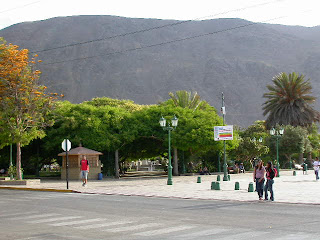 So here I am, once again spending some quiet time here in
So here I am, once again spending some quiet time here in this very tranquil small coastal city of some 15,000 people known as Taltal. Considering the fact that this is one of the few places I´ve spent time in during each of my four trips to Chile ought to say something about what my feelings for this place are. It´s quiet (usually, but not always), laid back (all the time), clean and scenic. Still, my friend/agent in Santiago, Andrés, sort of thinks I am a little off my rocker to "like" sich a place, and choose to spend days and days here rather than in some real tourist centers such as La Serena or Viña del Mar. But hey, people who know me recognize that I eschew crowded places and prefer to spend my time a little bit off of the beaten track.
this very tranquil small coastal city of some 15,000 people known as Taltal. Considering the fact that this is one of the few places I´ve spent time in during each of my four trips to Chile ought to say something about what my feelings for this place are. It´s quiet (usually, but not always), laid back (all the time), clean and scenic. Still, my friend/agent in Santiago, Andrés, sort of thinks I am a little off my rocker to "like" sich a place, and choose to spend days and days here rather than in some real tourist centers such as La Serena or Viña del Mar. But hey, people who know me recognize that I eschew crowded places and prefer to spend my time a little bit off of the beaten track.
Such sentiments fit, for me, here in Taltal. Above you can see a view of the nicely-shaded town plaza from Avenida Prat (1st picture); and above, a glimpse of the view northward of the Pacific shoreline looking north from the waterfront park. The structures on the right side of the picture are historic, going back to the late 19th century when Taltal was Chile´s third most important nitrate shipping port.
Anyway, that thougtht brings me to write, as the title of today´s blog reads, "a little bit about Taltal."
Taltal was founded in 1858, originally established as a port that would serve the emerging copper mining industry in Northern Chile. With the treaty of 1874, Chile ceded everything north of the 24th so. parallel to Bolivia, so for a time, Taltal was the northernmost port in Chile. Then, when the possibilities for exploitation of the huge nitrate resources began to change the face of the Atacama Desert and transformed its economy, the Chilean government looked toward developing Taltal as a major port to serve this dynamic new industry. In 1876, with the emergence of scores of "oficinas salitreras" (nitrate mining settlements) in the desert inland, Taltal began to grow exponentially.
Then the War of the Pacific (1879-1884) happened, and Chile was victorious over the combined forces of Bolivia and Peru, wresting territory from both, leaving Bolivia a suddenly landlocked country, which it remains today. The territorial adjustments effectively gave Chile the bulk of the extensive nitrate beds of the Atacama Desert (spoils of war?) and Taltal continued to grow, as the Taltal Railway Company linked the port to the nitrate mining settlements in the interior. Antofagasta and Iquique also grew as a result of the war´s outcome, and the fabled "Nitrate Clippers" sailed across the seas from Europe to load up with this precious raw natural resource to haul it to the world´s markets, to make both fertilizer and munitions.
At the end of the 19th Century, Taltal´s population was approximately 20,000, but that figure would shrink once the lucrative nitrate mining business was crippled by the eventual technological breakthroughs which allowed for the manufacture of synthetic nitrates. But thanks to the fact that the ocean provides for a lively fishing industry and the fact that the interior remains a source for other minerals, such as copper, silver and iodine, Taltal has survived. And now the city is looking to develop the potential for to serve an expanded tourist presence, basing their efforts on sandy beaches both here in town as well as a few kilometers south, at Cifuncho, plus the pleasant climate. So Taltal is growing, gradually.




No comments:
Post a Comment